Xiaomi Redmi Note 2 Review
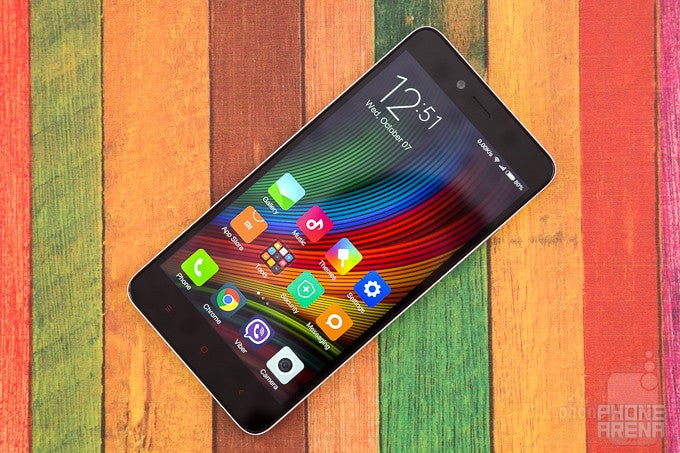
Introduction
Nowadays we talk about ultra affordable Chinese smartphones as if they popped out of thin air one day and never left. And while the originators of the first cheap Android smartphones are likely to remain forgotten by history, the name of the company that helped move that same needle on a scale is anything but. Xiaomi.
Known for selling devices at near cost, Xiaomi's fame is well-deserved on the whole: the handsets it pushes out are of a quality make, and the software on the inside is one of the best within the proprietary Android scene. Combined, this makes for a competitive proposition, and one of the latest out of its gates is the Redmi Note 2 phablet.
Sold for the equivalent of just $140 in China (and about $30 to $50 on top of that through e-tailers), the Note 2 sounds incredible on paper: a large, 1080p display, a powerful octa-core processor, 2 GB of RAM, and a 13MP camera. The question is, what's lost in the translation from a specs sheet to a device used in the real world?
Let's find out.
In the box:
- Xiaomi Redmi Note 2
- 2A wall charger
- microUSB to USB cable
Design
Okay first and second impressions. But why did the backplate have to creak so bad?
The Redmi Note 2's name says it all: It's a big device, and a successor at that. But quite a few things have changed since the original Redmi Note, and all of them for the better.
For starters, despite rocking identically sized screen panels, the Redmi Note 2 is considerably smaller, and significantly narrower, helping you almost forget that what you're handling is a truly large phone. At 5.64 oz (160 g) and 0.32 inches (8.25 mm), this affordable phablet is also much lighter and somewhat thinner than its predecessor. So far, so good.
Switching gears to aesthetics, we won't try and pretend that the Note 2 is anything approaching a masterpiece. It's quite ordinary looking, with a slightly rounded rectangular body made out of plastic. It's a decent kind of plastic — sturdy matte for the back that doesn't look as cheap as it should at those prices. Unfortunately, in less than two weeks time, the edges of our unit started showing traces of colorization, so it's probably best if you steer clear of the white model.
The backplate is removable, with access to the two SIM slots and microSD card hidden underneath. We have one gripe with the (easily removable) back, however: the imperfect fit. The back panel creaks towards the sides of the phone, and this only got worse and worse with every successive removal of the back. Similarly, the lock key and volume rocker are unsatisfying, with relatively short travel time.
Moving to the front, it's all glass and display, with the signature red capacitive keys of the Redmi family. On the top, you'll find that Xiaomi has actually fitted an IR blaster — unusual for this price class.
On the whole? Okay first and second impressions, eventually hurt by the creaky, easily colorized white backplate. Survivable for such an affordable phone, but definitely not ideal.
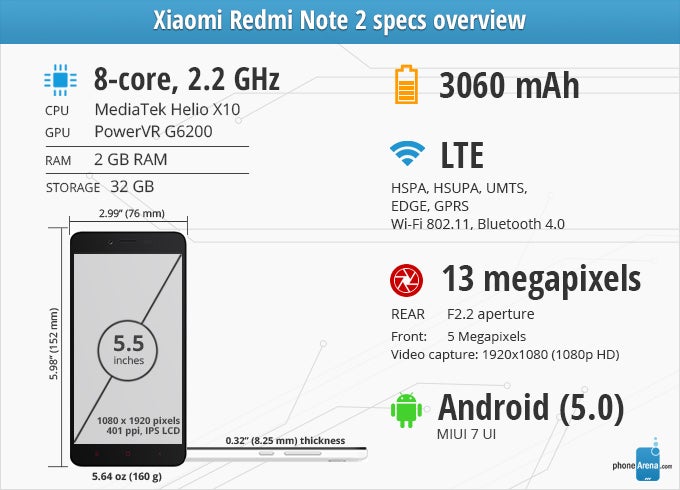
Display
The star of the show, the 5.5-incher is a balanced proposition without serious weaknesses.
So for most buyers, the 5.5-inch IPS LCD display of the Redmi Note 2 will be one of the main draws. And we're happy to say that Xiaomi is delivering a good experience.
Unlike its predecessor, which had to make do with a 720p screen, the Note 2 is outfitted with a much sharper, 1080 x 1920 resolution unit, good for the excellent 401 pixels per inch. We spent quite some time staring at it, and there's no pixelization of any kind.
The panel is quite color-accurate, too, especially for this class. We've got a decent color temperature of 7300K (6500K being ideal), though that still means colors are colder (more bluish) than they should be. Still, the Note 2 does well, with relatively small errors in reproducing primary and secondary colors. With a higher average gamma value of 2.27, the display also exhibits some artificial boost to contrast; so it's not perfectly natural, but still attractive.
Finally, the Redmi Note 2 also delivers on brightness: 499 nits at the top end, and 5 nits at minimum, which is great if you use your device before bed. The screen is visible outdoors, and can be even used when sunrays fall directly on it.
Interface and functionality
Xiaomi's secret sauce. This is one of the best proprietary Android skins right now.
With the Redmi Note 2, we wanted to stick to the well-beaten path, and not mess with the software that comes packed with it. Since this is the Chinese model that everyday Joes will be getting, there are a few caveats that ought to be detailed.
For starters, our Redmi Note 2 is still stuck with MIUI 6 — Xiaomi's proprietary Android skin —and is missing an official update to the latest MIUI 7. That, however, is not that big a deal when put next to the fact that the phone comes without Google's layer of apps, including the Play Store — you'll have to install them yourself, or make sure that the store you order from has done that for you. Even if you do that, you'll still have to handle all the bloatware apps loaded on the phone. Thankfully, they are not system-protected and can be deleted.
So let's talk MIUI. As mentioned, we're still waiting for the latest update of the custom software, though it's good to see that what we have is already based on Android 5.0.2 Lollipop. Besides, there's already quite a bit to love about Xiaomi's software, which is filled with helpful, as well as practical, features and shortcuts.
For example, the notification shade — which we all visit dozens of times a day — can be summoned by simply swiping downwards anywhere on the screen. Combined with Xiaomi's awesome one-handed mode, easily activated by swiping through the capactitive navigational keys on the bottom bezel, we already have two phablet-tailored improvements in quality of life. Other neat tricks include a shortcut to the flashlight (long-press Home key whilst at the lock screen), Apple Spotlight-like search bar summoned through a short swipe up on the homescreen, and 'anchorable' apps that won't be killed off if you dismiss all your recents. MIUI also comes with a comprehensive security suite that will help you dispose of large temporary files, control data usage, block calls, control app permissions, and even scan for viruses. There's also a wealthy choice of themes available if you get tired with the look of your homescreen, the ability to customize quick toggles, and many, many more. Easily one of the best proprietary Android skins on the market.
Processor and memory
The MediaTek Helio X10 chip delivers respectable performance.
A very big part of the appeal of the Redmi Note 2 is the sillicon under the lid: an octa-core, 64-bit MediaTek Helio X10 processor (MT6795T), with two clusters of four 2.2GHz Cortex-A53 cores working together in big.LITTLE. The GPU on duty is the 700MHz PowerVR G6200, helped by 2GB of LPDDR3 RAM.
Certainly not the highest of high-end configurations, but absolutely beastly when considered in the context of the $170 price tag. And it does its job more than well enough: navigational fluidity is consistently satisfying, with hiccups being an exception; apps open fast, and heavy 3D games like Asphalt 8 run with pretty satisfying frame rates. Apps like Tinder also run pretty well.
For those who care, synthetic tests corroborate our findings, with the Redmi Note 2 scoring well across the benchmark spectrum.
Finally, on memory: There's 16GB of storage available with our model, though a 32-gig version is also available from Xiaomi. Regardless of which one you choose to go for, you'll have access to a microSD card slot, allowing you to expand internal memory.
Internet and connectivity
An all-around competent device for the connected age.
The Redmi Note 2 comes with its own browser, which is actually one of the better custom solutions. Navigation is smooth in terms of both panning and zooming in and out of pages, and you get a smorgasbord of useful features. Perhaps most importantly, there's a built-in ad blocker, which will eliminate ads from pages, but fail to compensate for the blank space leftover. There's also a dedicate 'Night' mode, which changes the theme to a white-on-black one and dims the screen, a reader mode that allows you to focus on the text only, a data saving feature, and easy tabbing — just swipe from the edge of the screen to go to another tab.
If you want to use another browser, however, you'll have to go ahead and change the default browser in the Settings, as links and such will keep on opening with Xiaomi's own solution.
As for connectivity, the stack with the Redmi Note 2 is up to snuff for the price category. We've got FDD LTE with support for bands 1, 3, and 7, two micro SIM slots, Bluetooth 4.0, 5GHz Wi-Fi, and that aforementioned IR blaster for control over home electronics.
Camera
The weakest link in the chain, the 13MP Samsung sensor could use some work.
A Samsung-made, 13-megapixel camera is on duty with the Redmi Note 2, complete with f/2.2 lens and phase detection auto focus. The camera is capable of 1080p video recording at 30 frames per second and slow-motion video at 120 FPS, but a 4K UHD mode is absent. Up front, we've got an OmniVision-branded, 5-megapixel selfie snapper with f/2.0 lens, capable of 1080p video.
On the software side of things, Xiaomi's camera UI is coherent, minimalist, and well-executed all around. You can easily switch between the front and back shooters by swiping up or down on the view finder, and left and right to apply filters and change shooting modes, respectively. Of the latter, highlights include Smart mode (scene recognition), Beauty (brush-up) and Panorama, all of which are rather unimpressive, but more on that later.
Switching gears to image quality, it's a mixed bag, mostly protected by the cheap price tag of the phablet. In broad daylight, snaps come out soft, blurring out some of the detail that you'd expect from a 13MP unit, but with decent white balance and exposure. Dynamic range is average and HDR mode delivers attractive stills that don't look overly flat. Selfies come out pretty decent, but panoramas are just brutal — low resolution (less than 1.5MP) and all-around ugly.
It gets worse and worse when we go indoors and then shoot at night. The softness of the images is now accompanied by noise, and sharp focus becomes problematic, with even slight trembles causing some blur. Colors are decently close to realistic on the whole, though. Night photography, however, is not something you'll enjoy — the shooter just isn't good enough to both ensure enough light enters the lens and capture a snap fast enough to avoid blur.
Multimedia
Yikes, Chinese letters everywhere! Luckily, that's the only downside.
The built-in multimedia apps with Xiaomi's MIUI are all up to snuff, but we're not fans of the invasive Chinese letters and music/video portals available through the Music and Video apps.
Still, both of these work problem-free once you find your way around, and the latter is even quite feature-rich. With the former, though, you get only the basics, including pre-loaded equalizer presets for specific headphones from Xiaomi (say, Piston), and little else beyond that. With the latter, you can easily control brightness and volume by swiping up and down the left and right portion of the screen, set aspect ratio, and playback all kinds of video — including H.265, MKV, and XviD.
The loudspeaker on the back does a good job, too, of immersing you into your content, with very potent volume output and decent sound quality. Since the grill is so wide, it's also near impossible to accidentally muffle it, which is a bonus.
Call quality
Surprisingly good.
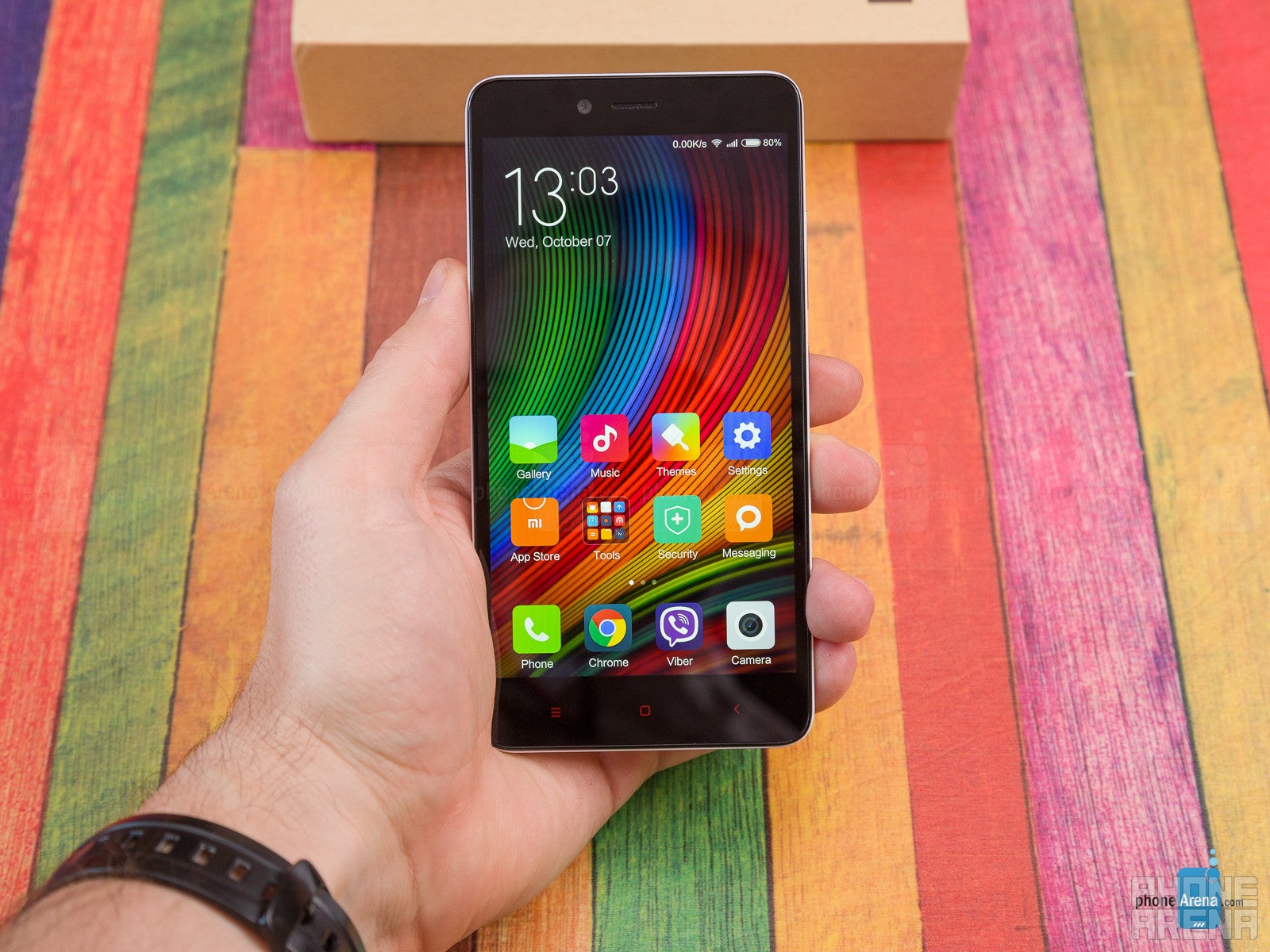
For one, the volume of the earpice is great, and sufficient to make out what's being said even in loud environments such as airports or busy malls. Voices transmitted through it sound a bit off, though, with a slighty muffled quality to them.
On the other side, things are about identical: strong volume output courtesy of the microphone, and satisfying voice reproduction. We'd know who we're talking to, even without looking at the caller ID.
Battery life
Good, not excellent.
After a decent showing so far, the last major test of the Redmi Note 2 is battery life.
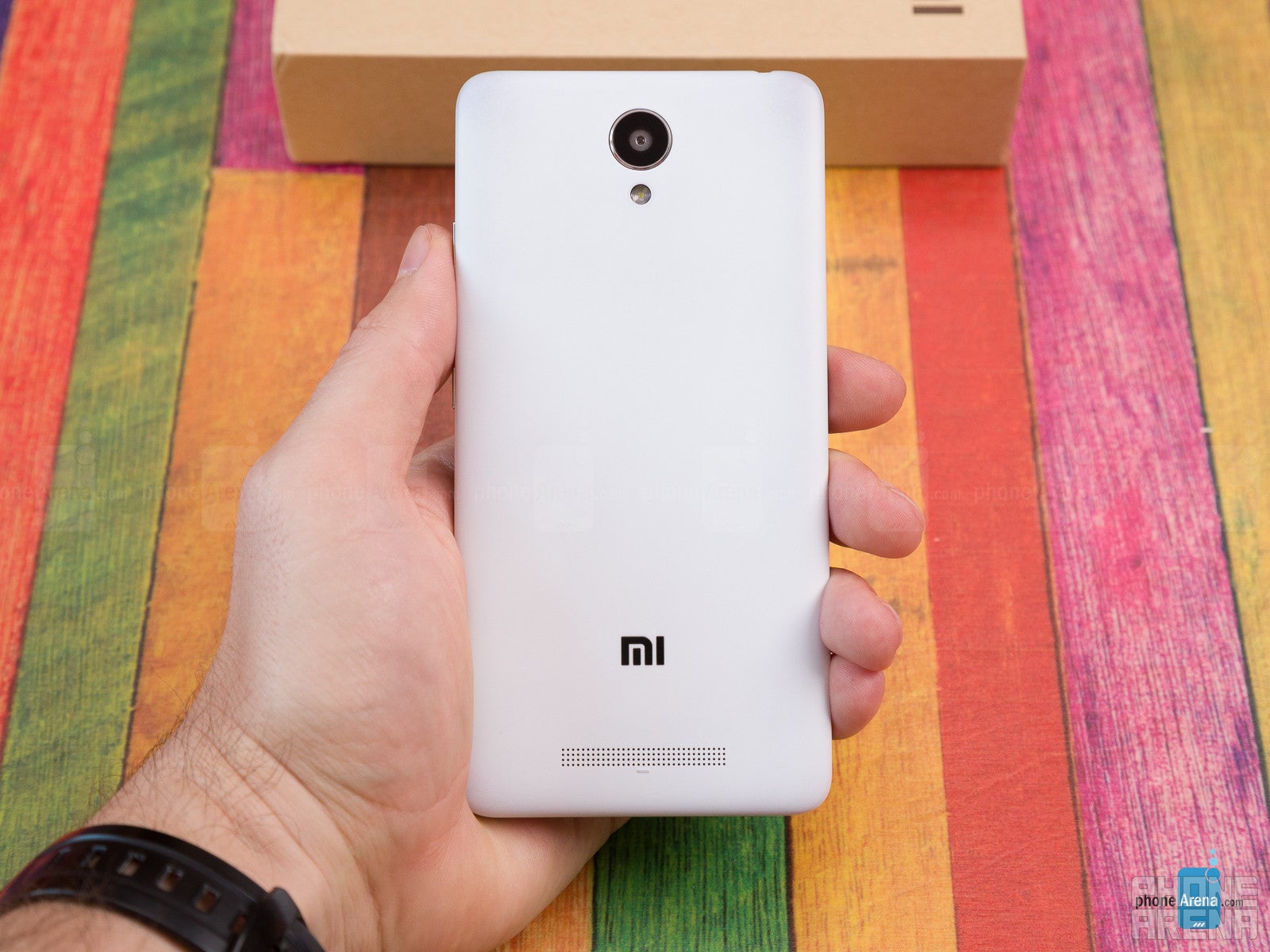
Depending on your personal use patterns and habbits, this results can translate to both up to two days of usage, or a single one — but of intense work. In our experience, we easily got a day and a half, but had to ease up a little to survive the fourthy eight hour.
Once your juice is out, you'll need just under 2 hours to get the battery back to full. Not a record-setting figure, sure, but very good on the whole, and specifically in this class. Thanks, 2A charger.
Conclusion
At about $170 to $190 (excluding any possibly applicable import fees), the Xiaomi Redmi Note 2 is a hard phablet to beat, though certainly not unopposed. For around that kind of money, you can get Meizu's m2 Note 5.5-incher, which sports a nearly identical specs list, but comes with a better camera and sweeter battery life. It's arguably the more attractive of the two, also. We've had some troubles with its software, though — in comparison, MIUI is madly powerful, but contained and well-behaved.
In any case, as far as successors go, the Redmi Note 2 ticks all the right boxes to qualify and end up in the 'worth' it corner. So if you've got the original Redmi Note, it'll be worth getting this one, as it's an all-around better performer. Honestly, our only real beef was with the wobbly backplate, which may be isolated to just our unit — so if possible, get some hands-on time before committing.
Bottom line: If you're on a tight budget, and want a competent, phablet-sized phone with MIUI, get this. If not, go take a look at Meziu's m2 Note.
Software version: Android 5.0.2 with MIUI 6.7.10.0
Thanks to ShopJoy.com.au for providing us with the review unit.

Follow us on Google News

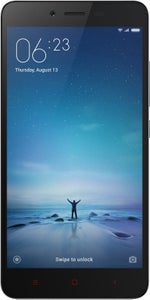

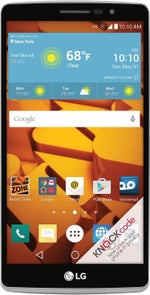

























Things that are NOT allowed:
To help keep our community safe and free from spam, we apply temporary limits to newly created accounts: